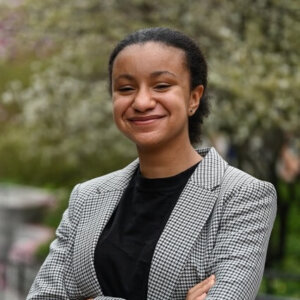Graphic by Canva/Olivia Haynie/Book cover designed by Lauren Sheldon
A Rooftop in Jerusalem
Michael Kinnamon
Köehlerbooks, 248 pages, $27.95
It’s 1969, and Daniel, a loosely practicing Christian undergrad from Yale, enrolls in a junior-year abroad program at Tel Aviv University. One night, he ends up alone in Jerusalem and is taken in by a Palestinian hotel owner. During his stay, Daniel, with the help of a kindly nun, finds a rooftop overlooking the Old City and feels a sense of spiritual awe wash over him. Thus begins Daniel’s decades-long relationship with the city.
He comes back a number of times, years apart, and observes Jerusalem’s changes. It becomes modernized, with the building of a shopping mall near the Jaffa Gate and a light rail stop at Damascus Gate. It also grows as a tourist destination and previously free areas become ticketed attractions. Military presence increases in the West Bank. Palestinian businesses Daniel used to patronize disappear and former Palestinian friends no longer extend the same hospitality.
American interest in Israel also transforms. In 1969, none of Daniel’s friends from home care about his abroad program. By 1992, Daniel is an instructor at the United School of Theology in Columbus, Ohio, and there is enough interest for Daniel to lead an interfaith trip for community members hoping to come together over a shared Holy Land. In 2003, he brings students who are particularly interested in social justice and the experiences of Palestinians.
Although the writing in A Rooftop in Jerusalem, the latest book from Michael Kinnamon (Summer of Love, The Nominee), can be a little schmaltzy and heavy-handed, specifically when it comes to dialogue, it’s a deft portrait of Jerusalem’s changing identity and the struggle for people to reconcile the city they had once known with its new reality. In 2003, as Israel begins building the West Bank barrier, Daniel asks himself, “Was this the Israel he had known in 1969?”, a question I’ve heard almost verbatim from multiple people in my life.
What never seems to change is Daniel himself, who is a passive character mostly reacting to opportunities presented to him — the interfaith trip and his class journey are someone else’s ideas. He does take the initial leap in 1969 of signing up for the Tel Aviv program but why he does this and his general drive in life remain obscure, even as he embarks on two marriages and struggles with unresolved feelings for Shoshana, an Israeli woman with whom he embarked on a relationship in 1970. This lack of depth makes it hard for the reader to feel invested in his personal story. By the end of the book, Daniel does experience some development and questions the non-committal attitude he had about the conflict up to that point, but we never figure out where he lands.
The novel closes in 2010 with Daniel meeting a tour group from Iowa who have been left without a guide. He shows them what he finds magical about Jerusalem — its history, its diversity, its architecture. It’s a testament to how one can still love a place while struggling with its transformations and an increasingly tumultuous political situation.
But the Israeli-Palestinian conflict has changed so dramatically since 2010 that the ending feels like a tragic reminder of a time when hopes for the future were higher. Now, for a number of Jews, holding onto that love for Israel and seeing its beauty has become more challenging than ever — and for some, completely impossible. One can imagine Daniel’s dismay at the democratic crisis in Israel and the horror that has been inflicted upon Israelis and Palestinians since October 7. If he went back to the rooftop in 2025, what spiritual reckoning would await him?

